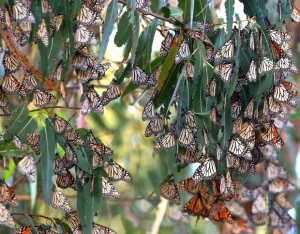the great migration

The annual migration of North America’s monarch butterfly is a unique and amazing phenomenon. The monarch is the only butterfly known to make a two-way migration as birds do. Unlike other butterflies that can overwinter as larvae, pupae, or even as adults in some species, monarchs cannot survive the cold winters of northern climates. Using environmental cues, the monarchs know when it is time to travel south for the winter. Monarchs use a combination of air currents and thermals to travel long distances. Some fly as far as 3,000 miles to reach their winter home!
Eastern monarchs

The eastern population of North America’s monarchs overwinters in the same 11 to 12 mountain areas in the States of Mexico and Michoacan from October to late March.
Monarchs roost for the winter in oyamel fir forests at an elevation of 2,400 to 3,600 meters (nearly 2 miles above sea level). The mountain hillsides of oyamel forest provide an ideal microclimate for the butterflies. Here temperatures range from 32 to 59 degrees Fahrenheit (0 to 15 degrees Celsius). If the temperature is lower, the monarchs will be forced to use their fat reserves. The humidity in the oyamel forest assures the monarchs won’t dry out allowing them to conserve their energy.
Monarchs cluster together to stay warm. Tens of thousands of monarchs can cluster on a single tree. Although monarchs alone weigh less than a gram, tens of thousands of them weigh a lot. Oyamel trees are generally able to support the clustering butterflies, but sometimes branches break.
western monarchs

Monarchs living west of the Rocky Mountain range in North America overwinter in California along the Pacific coast near Santa Cruz and San Diego. Here microclimatic conditions are very similar to that in central Mexico.
Monarchs roost in eucalyptus, Monterey pines, and Monterey cypresses in California. In February and March, the monarchs head inland in search of milkweed.
